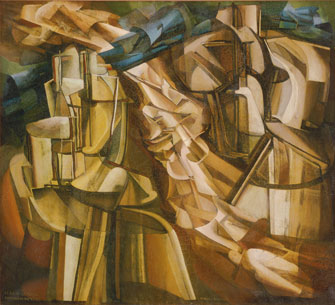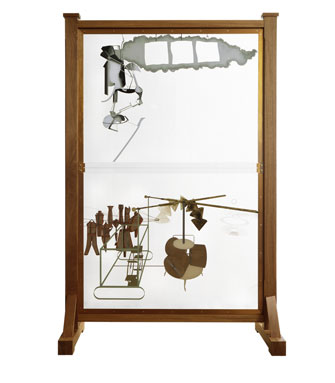Painter, Jokester,
Player, Thinker

“Le Roi et la Reine Entourés de Nus Vites” (1912). © 2014 photo The Philadelphia Museum of Art/ArtResource/Scala, Florence © Succession Marcel Duchamp/ADAGP, Paris 2014
Marcel Duchamp was not interested in painting pretty pictures, but he was a painter, a fact that is often obscured by the notoriety of his provocative “readymades,” notably the urinal entitled “Fountain” (1917), which are often blamed for sounding the death knell of painting. The current exhibition at the Centre Pompidou, “Marcel Duchamp, La Peinture Même,” reminds us of the painterly origins of this iconoclastic artist.
The exhibition excels at recreating the exciting early years of Duchamp’s career, when he and his older brothers, artists Jacques Villon and Raymond Duchamp-Villon (their sister Suzanne, also an artist, is barely present in the show), were hanging out in cafés in Montmartre, playing billiards, discussing the latest artists and movements, making erotic films and generally having a good old time. Many of their companions and Jacques Villon himself were cartoonists whose humorous drawings were published in revues of the time.
And Duchamp’s paintings? Like most young artists before they find their own way, he was trying his brush at every ism that came along, from Fauvism to Symbolism to Cubism. His influences were many, among them his mentor František Kupka (many of whose works are included in the exhibition), Odilon Redon and Edouard Manet.
While his paintings were often derivative and lacked brilliance, they showed talent. And Duchamp had something that many big-name artists at the time lacked: a sense of humor. He was asked to withdraw “Nude Descending a Staircase, No. 2,” the painting that made him famous in the United States, from the Cubist Salon des Indépendants in 1911 because he had written its title directly on the canvas, a touch of irony that was a no-no for doctrinaire Cubists.
He moved quickly from one style to another and soon became fascinated by machinery and the motion-dissecting experiments of Eadweard Muybridge in the United States and Etienne-Jules Marey in Europe, an influence that can be seen in his Cubist paintings, which are closer to those of the Italian Futurists in their concern with dissecting and depicting movement.
The show builds thoughtfully through all these influences and obsessions to show how Duchamp moved from painting to conceptual works, culminating with “The Large Glass,” a 
“The Large Glass” (1915-23/1991-92, second version) © Succession Marcel Duchamp/ADAGP, Paris 2014freestanding framed glass work incorporating a number of elements he had explored in his painterly career. He worked on this between 1910 and ’23, when he declared it unfinished.
Duchamp was a thinking artist rather than an instinctive one (in 1913 he took a couple of years off from art to work at a Paris library, the Bibliothèque Sainte Geneviève, and devoured works on philosophy, mathematics, optics and art). “I wanted to get away from the physical act of painting,” he once said. “I was far more interested in recreating ideas in painting…. I wanted to put painting once again at the service of the mind.” This makes it hard to love his work, which more often inspires appreciative laughter or puzzlement, but its importance in the history of 20th-century art cannot be denied. It would seem that we do indeed have him, along with fellow Dada sympathizers, to thank (or blame, depending on your point of view) for the explosion of conceptual art.
Centre Pompidou: 19, rue Beaubourg, 75004 Paris. Tel.: 01 44 78 12 33. Open 11am-9pm. Closed Tuesday. Métro: Rambuteau. Admission: €11-13. Through January 5, 2015. www.centrepompidou.fr
Click here to read all of this week’s new articles on the Paris Update home page.
Reader Reaction: Click here to respond to this article (your response may be published on this page and is subject to editing).
Support Paris Update by ordering books from Paris Update’s Amazon store at no extra cost. Click on your preferred Amazon location: U.K., France, U.S.
© 2014 Paris Update
Favorite